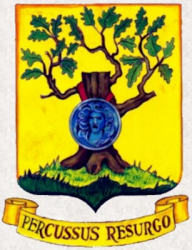The 308th Bombardment Group (H) was established by Army Air Forces on 28 Jan 1942. However, it was not until the 15th of April that the unit was activated at Gowen Field, Idaho. On that same day uthorization for, and activation of, the 373rd, 374th, 375th and 425th Bomb Squadrons occurred, with all of them assigned to the 308th. For the next three months little training occurred while the unit worked through its growing pains, resolving administrative and personnell acquistion difficulties. Then a totally new problem arose....all but four personnel were transferred to the 330th Bomb Group! While active on paper, it wasn't until September that personnel were taken from the 39th Bomb Group to form a cadre for the 308th, again making it a 'real force.' On 29 Sep the Group was designated an Operational Training Unit (OTU) with Wendover Field, Utah as its home station. The unit was fully manned by November, after receiving personnel from the 18th Replacement Wing.
During this time of trials and tribulations in forming a recognizable force, the flying echelon had transferred to Davis-Monthan Field, Tucson, Arizona, on 20 June for incidental training. Colonel Eugene H. Beebe, an experienced commander and recent member of Gen 'Hap' Arnold's staff, was relieved of command of the 302nd and ordered to command the 308th. Col Beebe also assembled his initial staff; Lt Trimble B. Latting (adjutant), Maj William A. Miller (exec), and Capt (Dr) William P. Gjerde (surgeon). The flight crews had been chosen and assigned for all four squadrons, having completed their respective training schools; ie., pilot, navigator, bombardier, engineer, radio and gunnery.
Members of the 308th had to complete three phases of training prior to moving overseas and entering combat. The flying personnel spent most of October in transition training with the B-24, training combat crews as well. Meanwhile, the ground echelon was acquiring, organizing and processing personnel and supplies at Wendover Field.
With the training complete and the personnel and supplies processed, the 308th Bombardment Group officially transferred to China early in 1943. The air echelon began flying its 'brand new' B-24D Liberators from Morrison Field, West Palm Beach, Florida on 15 Feb 43. Traveling by way of Central and South America, the Azores, Africa and India; while the ground echelon travelled by ship across the Pacific.
The group was assigned to the 14th Air Force and made many trips over the 'Hump' between India and China to obtain gasoline, bombs, spare parts, and other items they needed to prepare for and sustain their combat operations. The 308th supported Chinese ground forces; attacked airfields, coal yards, docks, oil refineries and fuel dumps in French Indochina; mined rivers and ports; bombed maintenance shops and docks at Rangoon, Burma; attacked Japanese shipping in the East China Sea, Formosa Strait, South China Sea and Gulf of Tonkin.
The Group received a Distinguished Unit Citation for an unescorted bombing attack, conducted through antiaircraft fire and fighter defenses, against docks and warehouses at Hankow, China, on 21 Aug 1943. They were awarded a second DUC for interdiction of Japanese shipping through 1944 and 1945. Maj. Horace S. Carswell, Jr. was awarded the Medal Of Honor for action on 26 Oct 1944, when, in spite of intense antiaircraft fire, he attacked a Japanese convoy in the South China Sea. His aircraft was so badly damaged that when he reached land he ordered the crew to bail out. Carswell, however, remained with the plane to save one man who could not jump because his parachute had been ripped by flak. Before Carswell could attempt a crash landing, the plane struck a mountainside and burned.
The group moved to India in June 1945, ferrying gasoline and supplies from there back into China, and sailed for the United States, where it was inactivated on 6 Jan 1946.
In his book, Chennault's Forgotten Warrior's: Saga of the 308th Bomb Group in China, Carrol V. Glines comments: " Although the 308th had a difficult time getting started because of the supply shortage and monsoon weather, it had built up an impressive record, especially when it is realized that all gas, bombs, ammunition, and other supplies had to be flown over the Hump in the unit's own planes, thus making it necessary to fly about three Hump flights for every combat mission."
Carrol Glines suggests, "Perhaps the greatest praise for the 308th came from General Chennault himself in his memoirs:
COMMANDERS
- Capt Harris K. McCauley - 11 May 1942
- Col Fay R. Upthegrove, 5 Jun 1942
- Maj Leroy A. Rainey; 15 Jul 1942
- Col Eugene H. Beebe, 16 Sep 1942
- Col William P Fischer,. 3 Nov 1943
- Col William D. Hopson, 1 Jul 1945;
STATIONS
- Gowen Field, Idaho - 15 Apr 1942
- Davis-Monthan Field, Ariz. - 20 Jun 1942
- Wendover Field, Utah - 1 Oct - 28 Nov 1942
- Pueblo AAB, CO - 30 Nov 1942 - 2 Jan 1943
- Kunming, China - 10 Feb 1943
- Hsinching, China - 10 Feb 1945
- Rupsi, India - 27 Jun - 15 Oct 1945
- Camp Kilmer, NJ - 5 & 6 Jan 1946
CAMPAIGNS
- India - Burma
- China Defensive
- New Guinea
- Western Pacific
- China Offensive
DECORATIONS
- Distinguished Unit Citations --
- China, 21 Aug 43
- East & South China Seas, Straights of Formosa,
and Gulf of Tonkin; 24 May 1944 - 28 Apr 1945
SQUADRONS
- 373rd Bombardment Squadron
- 374th Bombardment Squadron
- 375th Bombardment Squadron
- 425th Bombardment Squadron
